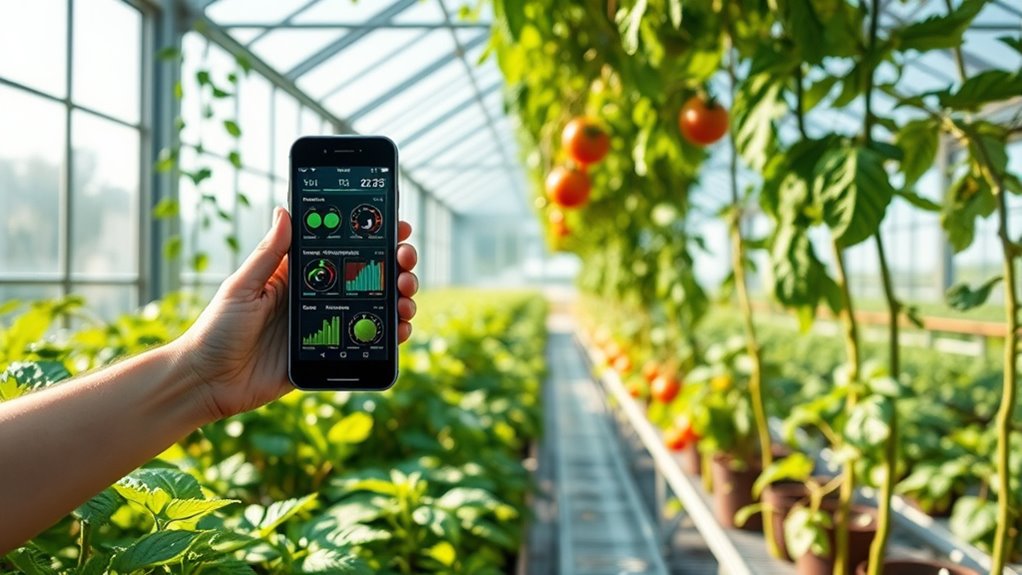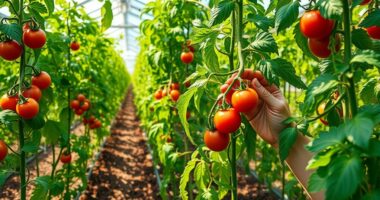To monitor plant health in your greenhouse, regularly inspect for signs like wilting, discoloration, or spots, which indicate stress or disease. Use environmental sensors to track soil moisture, temperature, and light levels, ensuring ideal conditions. Keep detailed records of pest sightings, growth patterns, and treatments to catch issues early. Consistent maintenance and technology integration help you create a thriving environment. Keep exploring to uncover effective strategies that keep your plants healthy and productive.
Key Takeaways
- Regularly inspect leaves, stems, and roots for discoloration, spots, mold, or pest signs to detect early health issues.
- Use soil moisture, temperature, light, and nutrient sensors to gather real-time environmental data for informed adjustments.
- Maintain optimal soil moisture (60-70%) and temperature (65-75°F) to promote healthy growth and prevent stress.
- Keep detailed records of plant growth, pest incidents, environmental conditions, and treatments for ongoing monitoring.
- Implement preventive measures like proper watering, sanitation, air circulation, and resistant plant varieties to reduce disease and pest risks.
Recognizing Common Signs of Plant Stress

Plants often show stress through noticeable changes in their appearance. If your plants look wilted or droopy, it could be a sign of watering issues—either overwatering or underwatering.
Overwatering can cause root rot, leading to yellowing leaves, while underwatering makes leaves dry out and curl. Nutrient deficiencies also manifest visibly; for example, nitrogen deficiency causes pale or yellowing leaves, and iron deficiency results in new leaves with chlorosis. Color accuracy impacts the overall appearance of your plants, making it easier to identify subtle stress signals. Utilizing fabric decorating markers might help if you want to label or mark your plants for better monitoring.
Watch for stunted growth or unusual leaf spots, which may indicate poor nutrient uptake. Spotting these signs early allows you to adjust watering schedules or address soil nutrient levels promptly. Additionally, understanding the geographical environment of your greenhouse can help you optimize conditions for plant health. Being aware of environmental influences such as temperature and humidity can further aid in maintaining optimal plant conditions. Implementing data-driven strategies can also assist in making precise adjustments to improve plant vitality.
Recognizing these common stress signals helps keep your plants healthy and thriving inside your greenhouse.
Monitoring Environmental Conditions Inside the Greenhouse
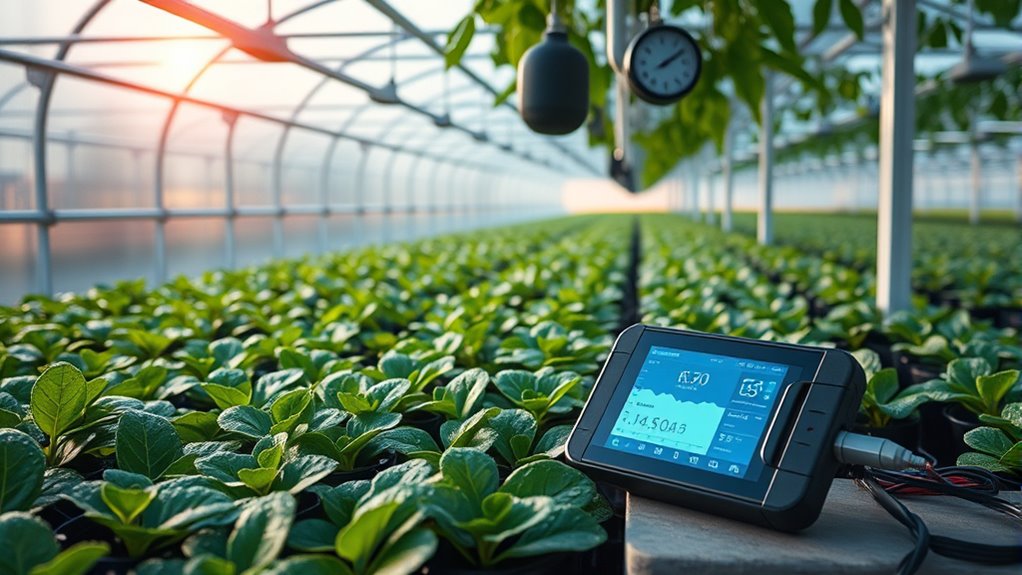
To guarantee peak growth, you need to keep a close eye on the environmental conditions inside your greenhouse. Regularly monitor soil moisture to prevent over- or under-watering, which can hinder plant development. Nutrient levels are equally critical; deficiencies or excesses affect plant health and yield. Use reliable tools like moisture meters and nutrient test kits for accurate readings. Here’s a quick overview:
| Condition | Ideal Range | Impact of Imbalance |
|---|---|---|
| Soil Moisture | 60-70% for most plants | Too dry causes stress; too wet leads to root rot |
| Nutrient Levels | Balanced, according to plant needs | Deficiencies stunt growth; excess causes toxicity |
| Temperature | 65-75°F (18-24°C) | Too hot slows growth; too cold hampers development |
Maintaining optimal environmental conditions is essential for healthy plant growth and maximizing productivity. Additionally, monitoring glycolic acid benefits can be relevant for plant health, as it promotes healthy skin and tissue, which can be analogous to maintaining plant tissue vitality. Regularly checking soil health ensures that plants receive the necessary nutrients and support for sustained growth, and understanding the impact of air quality can also help optimize overall greenhouse conditions. Moreover, adhering to proper ventilation standards can significantly improve air circulation and reduce disease pressure within the greenhouse.
Using Technology to Track Plant Health

Using technology to track plant health makes managing your greenhouse more efficient. Sensor technologies can provide real-time data on moisture, light, and temperature, helping you catch issues early. Implementing security systems such as surveillance cameras and motion detectors can also help monitor your greenhouse environment and deter theft or vandalism. Understanding the AI Bifurcation can also inform you about future technological shifts that may impact how greenhouse monitoring evolves. Additionally, integrating sensor data analysis can enhance decision-making by providing insights into plant health trends over time. Incorporating tuning methodologies from automotive applications can inspire innovative approaches to optimizing greenhouse conditions for better plant growth. Being aware of regional resources and tools can further improve your ability to select suitable monitoring equipment tailored to your location.
Sensor Technologies for Monitoring
Sensor technologies have revolutionized how you monitor plant health in your greenhouse by providing real-time, accurate data. You can now quickly identify issues and enhance conditions.
Here are four key sensor types:
- Soil moisture sensors help you maintain ideal watering schedules, preventing over- or under-watering.
- Nutrient sensors measure essential elements, ensuring plants receive proper nutrition.
- Temperature sensors track environmental conditions, allowing you to adjust heating or cooling.
- Light sensors monitor illumination levels, ensuring plants get adequate light for photosynthesis.
Data Analysis and Interpretation
By analyzing data collected from your sensors, you can gain valuable insights into your plants’ health and growth patterns. Monitoring soil moisture and nutrient levels helps you identify when plants need watering or fertilization. Use data trends to adjust your greenhouse environment proactively, preventing issues before they escalate. To interpret your data effectively, consider this table:
| Parameter | Ideal Range | Action Needed |
|---|---|---|
| Soil Moisture | 40-60% | Water plants if below range |
| Nutrient Levels | Adequate nutrient balance | Fertilize if levels are low |
| Temperature | 65-75°F | Adjust heating/cooling as needed |
| Humidity | 50-70% | Increase/decrease humidity accordingly |
Regular review of this data assures excellent conditions, promoting healthy plant growth and maximizing yields.
Identifying and Managing Pest Infestations
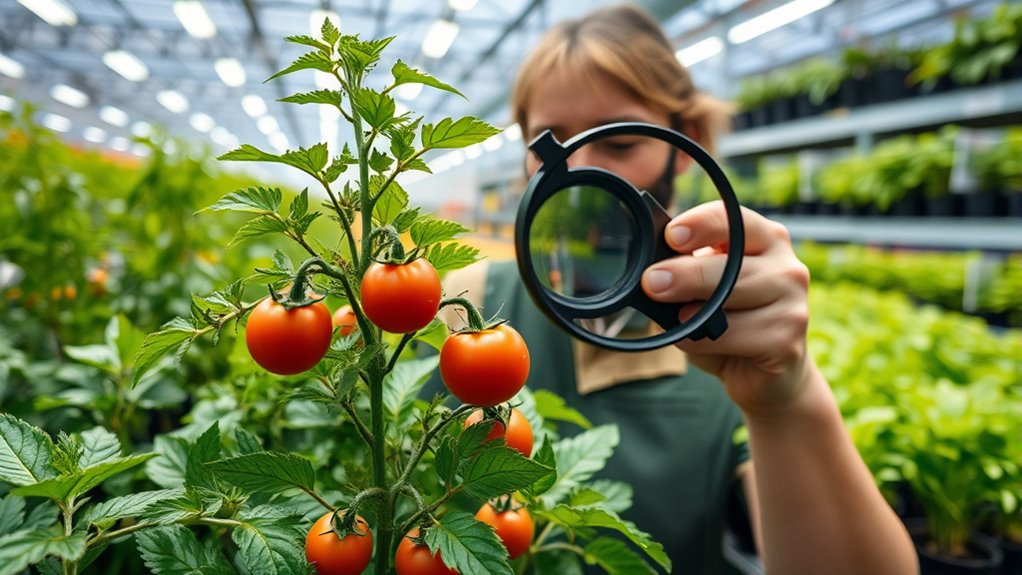
Have you noticed tiny holes in your leaves, sticky residue, or unusual spots on your plants? These signs indicate a pest infestation that needs your attention.
To manage pests effectively, consider these steps:
- Inspect plants regularly for pests or eggs, especially on undersides of leaves.
- Use companion planting to repel pests naturally—plants like marigolds deter many insects.
- Implement soil sterilization to eliminate hidden pests and larvae in the soil. Soil sterilization can effectively reduce pest populations hiding below the surface. Additionally, selecting the right wicking materials enhances the self-watering system’s efficiency, helping maintain healthy plants less susceptible to pests.
- Remove heavily infested plants promptly to prevent spreading pests to healthy ones.
Being aware of financial management practices can help you allocate resources efficiently for pest control efforts. Stay vigilant and act quickly. Combining vigilant monitoring with practices like companion planting and soil sterilization helps keep pests at bay. Additionally, understanding state-specific tax laws can optimize your budget for pest management supplies and techniques.
This proactive approach guarantees your greenhouse remains healthy and pest-free without relying solely on chemical controls.
Detecting and Preventing Plant Diseases
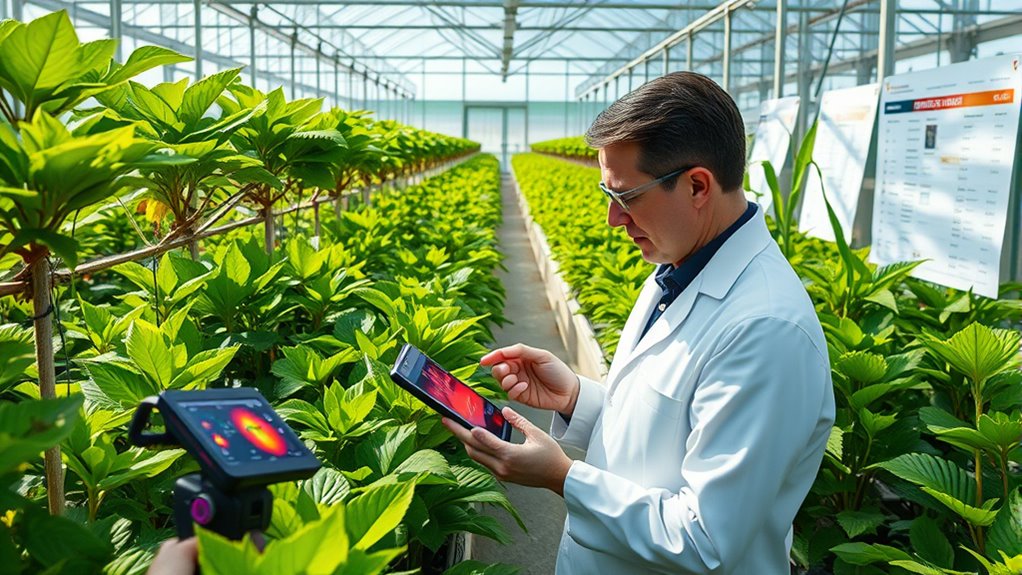
While catching pests early can save your plants, recognizing the signs of plant diseases is equally important for maintaining a healthy greenhouse. Regularly inspect leaves, stems, and roots for discoloration, spots, or mold. Ensuring proper soil nutrition and water quality helps prevent disease development. Healthy soil with balanced nutrients boosts plant immunity, while clean water reduces pathogen spread. Use this table to guide your prevention efforts:
| Disease Indicator | Prevention Tip |
|---|---|
| Wilting, spotting, mold | Check soil nutrition; avoid overwatering |
| Yellowing leaves, root rot | Improve water quality; ensure proper drainage |
| Powdery mildew, spots | Increase airflow; monitor humidity levels |
| Leaf curling, stunted growth | Use disease-resistant plant varieties |
Consistent monitoring and proactive adjustments keep your greenhouse disease-free. Proper water management is essential, as it directly influences plant health and disease prevention.
Keeping a Plant Health Record Log
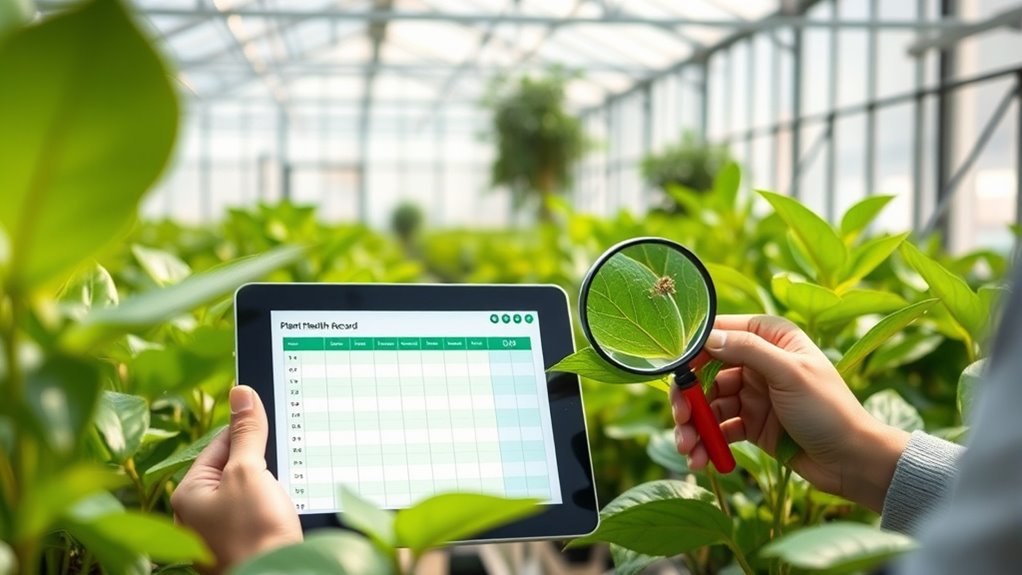
Keeping a plant health record log helps you spot patterns over time. By recording growth progress, you can identify when plants thrive or struggle.
Tracking pest incidents also lets you catch recurring issues early and take targeted action.
Recording Growth Patterns
Recording growth patterns is a vital step in monitoring your plant health, as it provides tangible data to identify trends and detect issues early. Keeping a detailed log helps you observe how your plants respond to pruning techniques and soil nutrient management.
To effectively track growth, consider these steps:
- Measure plant height and record weekly changes.
- Note leaf size, color, and any signs of nutrient deficiencies.
- Document flowering or fruiting stages.
- Record environmental conditions to correlate with growth patterns.
Regularly reviewing these records helps you fine-tune pruning techniques and adjust soil nutrients, promoting healthier growth.
Consistent documentation guarantees you catch problems early, making your greenhouse management more efficient and your plants more resilient.
Tracking Pest Incidents
Tracking pest incidents is a key part of maintaining healthy plants in your greenhouse. By keeping a detailed record, you can quickly identify patterns, such as pest outbreaks or insect migration trends.
When you notice a sudden increase in pest activity, note the date, affected plants, and pest type. Tracking these incidents helps you determine if the problem is localized or spreading, allowing you to respond promptly.
Monitoring pest movements also reveals migration routes, so you can implement targeted control measures. Regularly updating your plant health record log ensures you stay ahead of infestations and prevent widespread damage.
This proactive approach makes pest management more effective, saving your plants and reducing the need for extensive chemical treatments.
Implementing Preventative Maintenance Practices
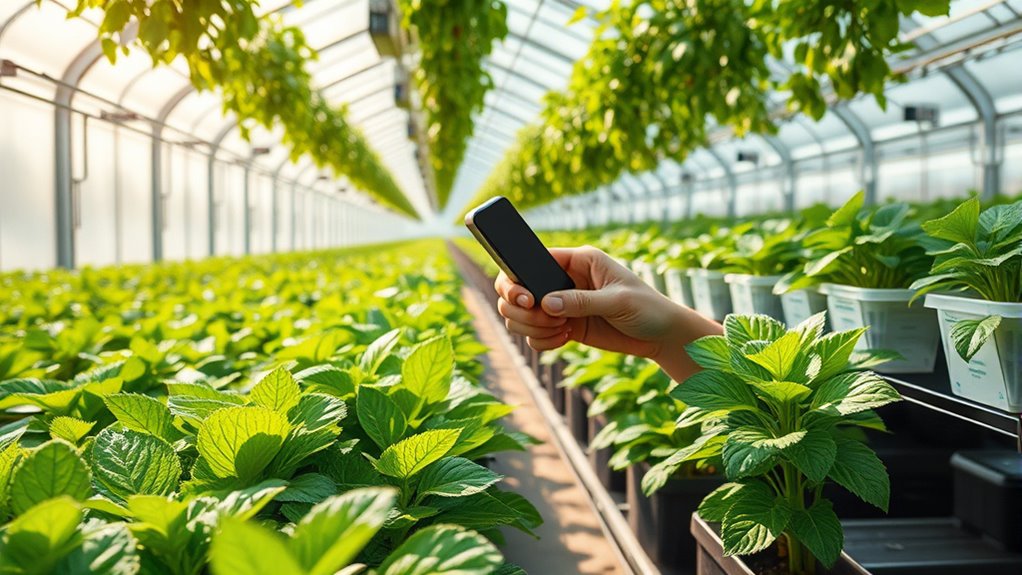
Implementing preventative maintenance practices is essential for maintaining ideal plant health in your greenhouse. Regularly inspect and clean your equipment to prevent disease spread. Incorporate soil amendments to improve soil structure and nutrient availability, supporting healthy root systems.
Focus on nutrient cycling by rotating crops and adding compost to maintain soil fertility. Here are four key practices:
- Schedule routine cleaning of tools and surfaces to reduce pathogen risks
- Apply soil amendments to enhance soil health and support nutrient cycling
- Monitor and adjust irrigation to prevent overwatering or drought stress
- Regularly inspect plants for early signs of disease or pest issues
Assessing Growth Patterns and Overall Plant Vitality

To guarantee your greenhouse plants are thriving, it’s crucial to evaluate their growth patterns and overall vitality regularly. Observe how plants develop—are stems straight, leaves vibrant, and new growth consistent?
Check soil nutrient levels to ensure plants receive essential minerals; deficiencies can stunt growth or cause discoloration. Healthy plants typically exhibit strong, upright stems and lush foliage.
Use proper pruning techniques to encourage airflow, remove dead or diseased parts, and promote balanced growth. Consistent pruning not only maintains plant health but also helps you spot early signs of stress or pests.
Frequently Asked Questions
What Are the Best Tools for Real-Time Plant Health Monitoring?
When choosing tools for real-time plant health monitoring, focus on sensors with high accuracy to get reliable data.
Look for systems that facilitate seamless data integration from multiple sensors, giving you a thorough view of your plants’ conditions.
Use tools like soil moisture sensors, temperature monitors, and leaf wetness sensors, all connected via smart platforms.
This way, you can quickly identify issues and optimize your greenhouse environment efficiently.
How Often Should I Calibrate My Greenhouse Sensors?
Did you know regular sensor maintenance can extend sensor lifespan by up to 30%?
You should calibrate your greenhouse sensors at least once every three months, or more frequently if conditions change often.
Following a consistent calibration schedule ensures accurate readings, helping you make better decisions.
Keep track of calibration dates, and don’t forget to follow the manufacturer’s guidelines for your specific sensors to maintain ideal performance.
Can Natural Remedies Effectively Replace Chemical Pest Controls?
Natural remedies can be effective as part of an integrated pest management strategy, offering organic pest solutions that reduce reliance on chemicals. You might find success using neem oil, insecticidal soaps, or companion planting to control pests naturally.
While they work well for minor infestations, for severe issues, combining organic solutions with targeted chemical controls guarantees thorough protection. This approach helps maintain your greenhouse’s health without sacrificing sustainability.
How Can I Optimize Light Exposure for Diverse Plant Species?
To optimize light exposure for diverse plant species, focus on effective light management by adjusting the distance and angle of your grow lights. Use adjustable fixtures to tailor light intensity and duration based on each plant’s needs.
Prioritize photosynthesis optimization by ensuring plants receive the right spectrum and adequate light, which boosts growth and health.
Regularly monitor and modify your setup to create an ideal environment for all your plants.
What Are Early Indicators of Nutrient Deficiencies in Plants?
You can spot early nutrient deficiencies in your plants through signs like leaf discoloration, which often indicates problems with soil pH affecting nutrient uptake.
Keep an eye out for yellowing leaves or pale patches, especially on new growth.
Regularly testing soil pH helps you catch imbalances early, ensuring your plants receive the right nutrients.
Addressing these issues promptly keeps your plants healthy and thriving.
Conclusion
By staying vigilant and using modern tools—think of it as your own personal Jacquard loom—you can keep your greenhouse thriving. Regularly check for signs of stress, pests, or disease, and keep detailed records. Implement preventative measures and monitor growth patterns to catch issues early. Remember, your attentive care is the key to healthy, vigorous plants. With a little effort, you’ll ensure your green oasis flourishes like a well-tuned symphony in the age of the digital renaissance.
